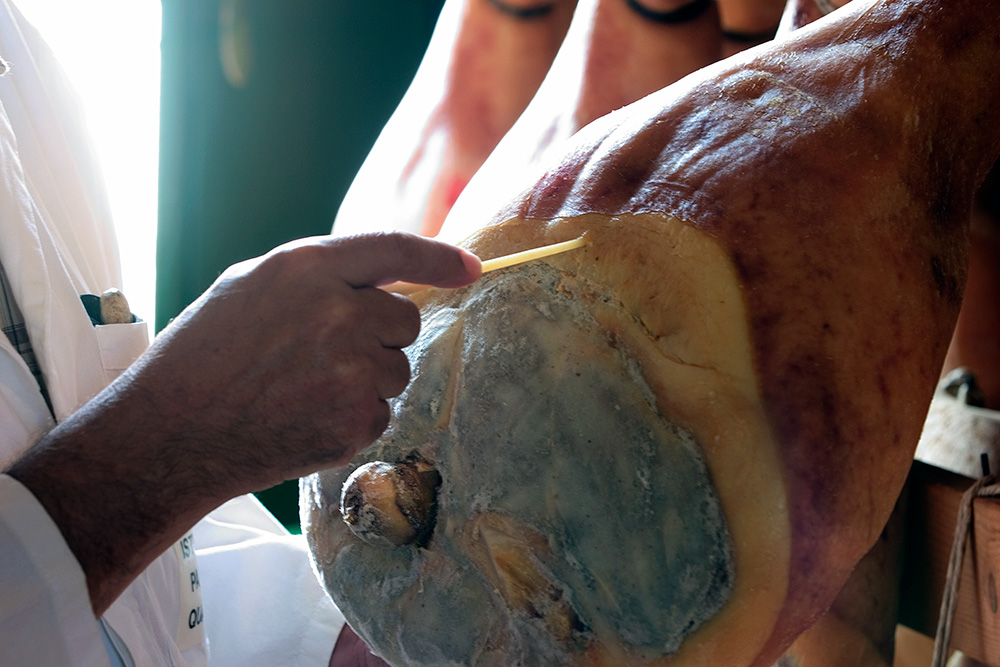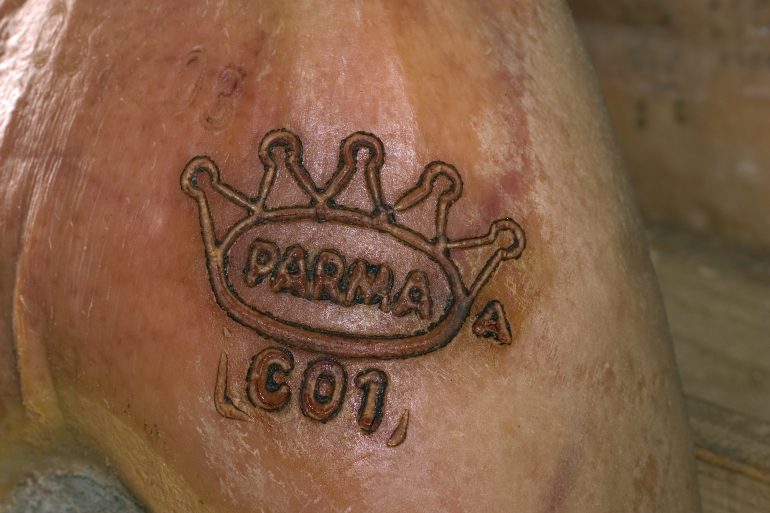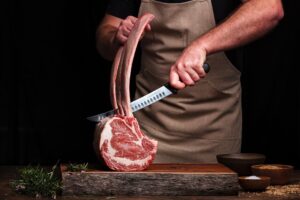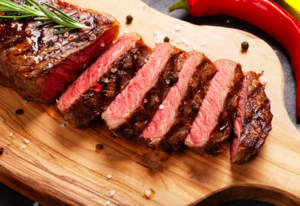The name Parma Ham is mouth-watering. It melts in the mouth with a soft and delicate texture. Savoriness dominates up front, but is braced with a delightful sweetness in the finish. Incredible!
To produce this prestigious ham, it involves strict selection of raw materials and meticulousness of the artisans. Let’s dive into this poetic artwork!
Table of Contents
What Is Parma Ham?
Parma Ham is a kind of ham originating from Italy that is cured, dry aged, and generally sliced and served raw.
The word “Prosciutto” translates to “ham” in Italian. Typically, there are two types of prosciutto—prosciutto cotto which is cooked ham; and prosciutto crudo which is uncooked but cured.
The most renowned prosciutto crudo comes from Parma, which is Parma Ham. And the Italian name of Parma ham is “Prosciutto di Parma”. Many people misunderstood that prosciutto is the same thing as Parma ham. But actually Parma ham is just a variety of prosciutto (ham).
► Read More: 8 Types of Ham You Must Try! | Shopping Tips for Newbies in Ham
How Does Parma Ham Taste?
The authentic Parma Ham has a rosy pink color with a thin layer of oil after being sliced. It has a delicate, soft and melt in the mouth texture while tastes salty with a pleasant mildly sweet finish.
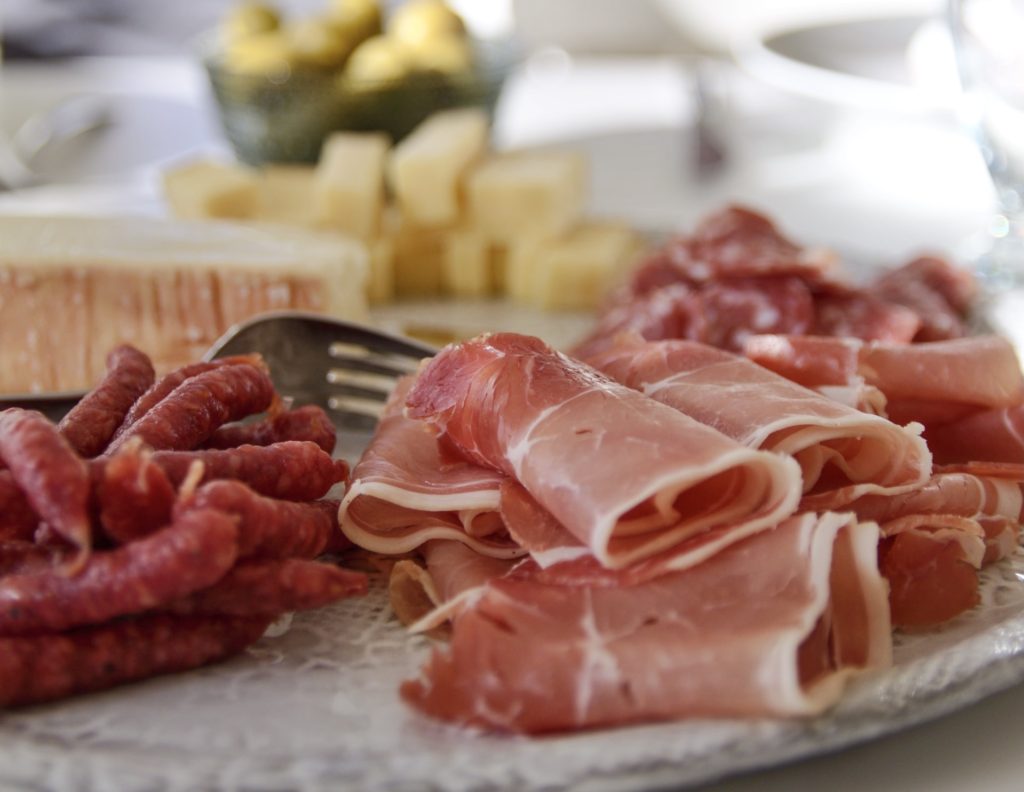
What Makes Parma Ham?
Making Parma Ham primarily involves two ingredients—specially bred Italian pigs and sea salt.
Different from the pigs for Iberico Ham, the pig breeds of Parma Ham are more general, yet they are raised in a special way. Parma hams are made from the hind legs of castrated male Duroc, Landrace and Large White pigs raised in Italy, specially used for Parma ham production. They must be born and bred with strict guidelines. And only the pigs in approved farms from 10 regions of northern and central Italy are qualified for the production.
Feed is always an important factor for the meat quality. Apart from the breeds and regions, the pigs must be fed with barley, corn, and whey from Parmigiano Reggiano cheese production, another signature Italian food. That’s why Parma hams taste sweet, full-bodied and soft.
Parma Ham is also covered by a Protected Designation of Origin (PDO; DOP in Italian) as other delicacies. Only sea salt is used during the production process of the authentic Prosciutto di Parma. More criteria will be discussed below.
► Read More: 6 Best Pig Breeds For Meat Around The World
How Is Parma Ham Made?
Step 1: Slaughtering and Cooling
Firstly, prepare the main character—pigs. As mentioned in the above, the pigs for Parma ham production are particularly bred and fed, and come from 10 regions of Italy. To ensure the quality, the pigs have to rest and fast for 15 hours before slaughtering, and then they must be processed within 5 days. After slaughtering, the selected pig legs are washed and cooled at 0°C (32°F) for 24 hours. This is to make trimming easier and keep it hygienic.
Step 2: Trimming
This step is to trim off the unwanted fat and skin as well as making the legs in a unified shape. The unified shape ensures all the Parma hams meet the required fat to meat ratio and have the uniform appearance. Also, trimming can facilitate salting the legs. The flawed legs, even the flaw is small, will be discarded during this stage.
Step 3: Salting
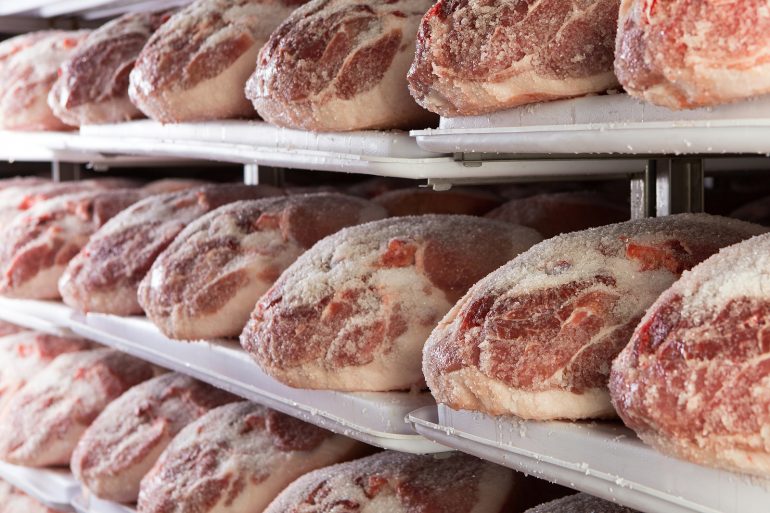
To maintain the naturalness of the Prosciutto di Parma, no other preservative is added during the production except sea salt. The whole process of salting is completely by hand in the traditional way.
After that, the artisans will refrigerate the salted ham at a temperature from 1°C to 4°C (34°F to 39°F) with a humidity level of 80%. The environment is strictly controlled because the unappropriate temperature and humidity may cause insufficient absorption of salt or deterioration of meat. After a week, they will further coat a thin layer of salt on the ham and keep hanging in the refrigerated room.
After 60 to 90 days, the salted hams will be sent to washing.
Step 4: Washing
Next, the Parma Hams are washed several times with warm water to eliminate the salt and impurities. And they are then hung in a drying room for a few days.
Step 5: First Curing
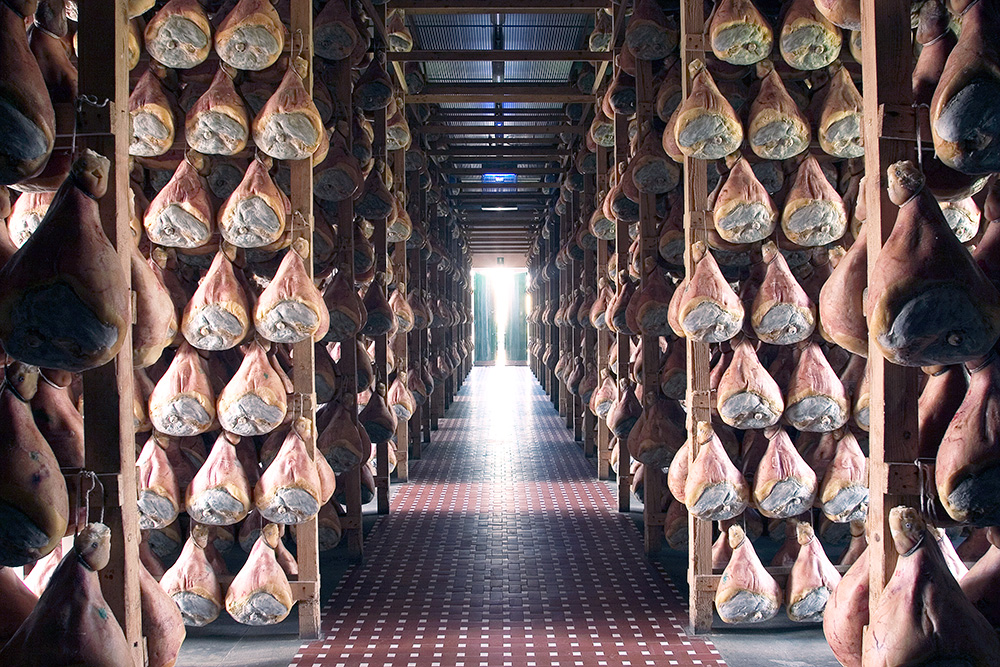
At this phase, the artisans hang the Parma Hams on special wood frames (called scalere) in an aging room.
Generally speaking, the rooms for dry aging hams have a high ceiling and also arrays of windows on both sides. The windows are the key for regulating airflow, humidity and temperature which are significant for the quality. The windows will be opened when the outdoor temperature and humidity are appropriate which is decided by the experienced artisans. This is to dry the ham gradually and constantly.
This lasts for about 3 months, at the end of this stage, the surface of the ham becomes dried and hardened.
Step 6: Greasing
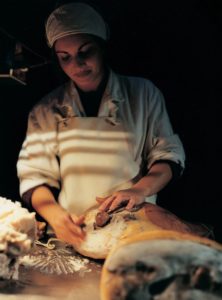
After first curing, it’s time for greasing. It is a procedure that coats the mixture of lard, salt, pepper and sometimes ground rice on the Parma Ham. The idea is to protect the ham and prevent moisture loss too rapidly.
Step 7: Final Curing
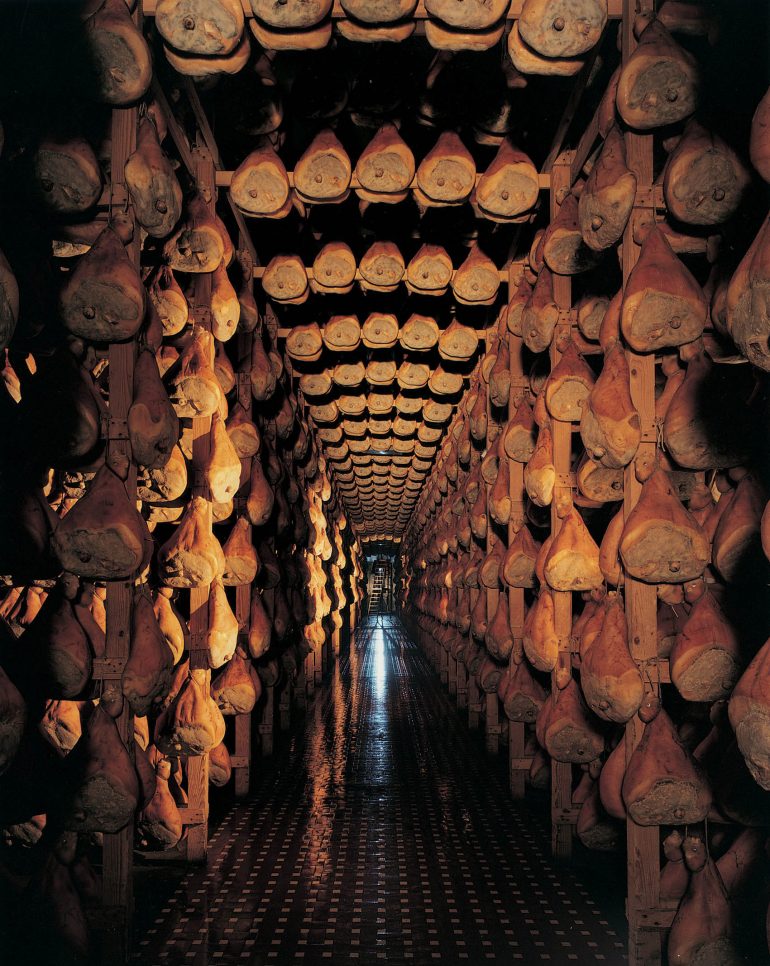
At the seventh month, it comes to the final curing stage. The artisans will transfer the Parma hams to the cellar where it has less air and light until it is fully matured.
The minimum curing time (counting from the time of salting) is 400 days and some even have been cured for up to 36 months. The longer aging time produces the richer, more complex and drier Parma Ham. Younger ham is good for cooking while the older one is incredible to taste as-is.
Step 8: Branding
If the Parma Ham fulfills a bunch of standards, it will earn an official fire-branding with Ducal Crown. This is offered by the independent institution—Consorzio del Prosciutto di Parma, it guarantees the production process is correct and the quality is the best.
Apart from the required ingredients and process, the final quality is inspected. The inspectors will insert a horse bone needle to five specific parts of the Parma Ham. Horse bone needles can quickly absorb and release scents. The scent is an indicator of the quality of ham and so they use it for testing. If the appearance, color and aroma of the final Parma Ham passes the standard, they will grant the prestigious Parma Crown. The Crown also shows the identification code of the manufacturer.
► Step 9: Slicing
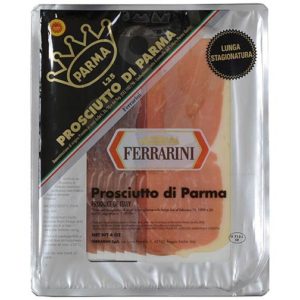
You can find the whole Parma Ham in the market, but the sliced version is more common. The slicing process of authentic Prosciutto di Parma is also carried out in the Province of Parma with strict inspection. This aims to assure the quality of the ham. There is also a Ducal Crown logo in a black triangle on the top left of the packets for these pre-sliced premium Parma Ham. The sliced version is as good as the whole ham, and more friendly to store.
Prosciutto di Parma PDO
It’s common to hear the name Prosciutto di Parma followed by an abbreviation “PDO” (or DOP in Italian). PDO stands for Protected Designation of Origin which guarantees that all parts of preparation, processing and production process occurs in a specific region. On top of all that, the PDO status makes all the stuff traceable including every part of production which facilitates quality control.
The whole process of making Prosciutto di Parma PDO takes place in the Province of Parma. The unique ecological and environmental conditions as well as the traditional craftsmanship of Parma deliver the distinctive flavor to the ham.
There are several requirements to crown the PDO mark to the Parma Ham. The followings are some of the examples:
- All parts of production must be carried in the Province of Parma (but the raw materials can originate from several regions);
- Only particular pig breeds can be used such as Landrace and Large White;
- The pigs must be at least 9 months old, weigh around 160 kg;
- The pigs must be fed with certain feeds and certificated;
- Every Parma Ham must be 100% natural with no other preservatives or additives
Why Is Parma Ham So Expensive?
The top-quality of raw materials, artisanal and long production process as well as the strict quality control are the main reasons. Every part of Parma Ham ranging from picking the ingredients, traditional craftsmanship to yearlong aging are valuable. Plus, the rigorous inspection system makes everything highly traceable. All of these bear the high cost but also guarantee the finest to the gourmets. It’s worth the price!
Is Parma Ham Healthy?
Parma Ham is rich in protein. Protein is essential for our body to build and repair muscles and other body tissues. It also boosts metabolism and fat burning rate which is a great helper during weight loss.
As a kind of cured meat, you may be concerned about the preservatives. No worries. Prosciutto di Parma is outstanding from other processed meats. It is 100% natural and free of artificial colors, flavors or preservatives.
And of course, this ham tastes salty and you must be worried about the sodium content. Parma Ham has notably less sodium than other hams. This is because the producers have improved the production techniques in the past decade so as to lower the sodium content. Each Prosciutto di Parma contains only 5.3% of salt content on average.
How to Enjoy Parma Ham?
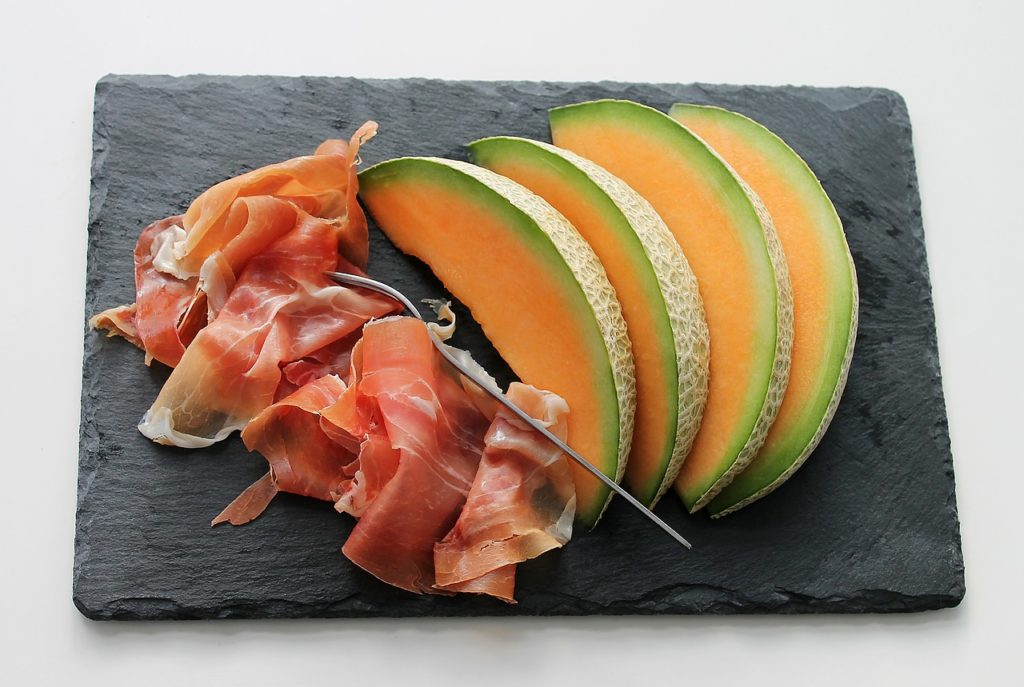
The most popular way to enjoy Parma Ham is eating it with melon. Melon provides the freshness and sweetness which is the best to balance the saltiness of Prosciutto di Parma. It also goes well with other seasonal fruits like fig, or with cheese, hence it is bravo on a charcuterie board as well.
Actually, older Parma Ham is fabulous to eat on its own while the younger version is ideal in cooking. It is delicious in pizza, pasta, and salad which lifts the dish to the next level.
Never miss the drinks. Lambrusco, a sparkling red wine from the same region, is the classic match with Parma Ham. It is ruby red and full-bodied with a strong, fresh fruit aroma. Fruity white wine and craft beer are also a good choice to pair with.
Where to Buy Parma Ham?
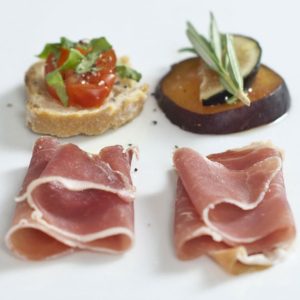
GourmetFoodStore.com provides various choices of Prosciutto di Parma. For example, they have sliced Parma Ham or whole leg, boneless or bone in versions, as well as young-aged and old-aged hams. It’s totally up to you!
We have a 10% discount code: KitchenTeller for you. Just apply it on the Basket page or the Payment page during checkout.
How To Store Parma Ham?
The unopened vacuum sealed Parma Ham can be refrigerated at 34°F to 40°F (1°C to 5°C) for up to 2 months. If it is opened, it can be kept for a week but it’s best to finish it within two days. Always check the use-by date.
Do wrap it with cling paper appropriately after opening it and store in the refrigerator. It is suggested to rest the refrigerated ham at room temperature before an hour of eating.
Summary
Parma Ham is a piece of artwork. It contains the honorable Italian traditional craftsmanship. Each Parma Ham is produced under strict and professional management and so they are highly revered all over the world. It’s a must-try!
► Read More: Iberico Ham: Why Is It So Expensive? How to Choose and Eat?
► Read More: What Is Salami Made Of? Is It Healthy & Keto? | Salami 101


